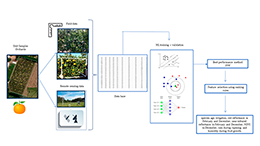About identification of features that affect the estimation of citrus harvest
DOI:
https://doi.org/10.48162/rev.39.096Palabras clave:
MODIS, SVM, selección de variables, aprendizaje automático, naranja dulce, tangor MurcottResumen

Accurate models for early harvest estimation in citrus production generally involve expensive variables. The goal of this research work was to develop a model to provide early and accurate estimations of harvest using low-cost features. Given the original data may derive from tree measurements, meteorological stations, or satellites, they have varied costs. The studied orchards included tangerines (Citrus reticulata x C. sinensis) and sweet oranges (C. sinensis) located in northeastern Argentina. Machine learning methods combined with different datasets were tested to obtain the most accurate harvest estimation. The final model is based on support vector machines with low-cost variables like species, age, irrigation, red and near-infrared reflectance in February and December, NDVI in December, rain during ripening, and humidity during fruit growth.
Highlights:
- Red and near-infrared reflectance in February and December are helpful values to predict orange harvest.
- SVM is an efficient method to predict harvest.
- A ranking method to A ranking-based method has been developed to identify the variables that best predict orange production.
Descargas

Descargas
Publicado
Cómo citar
Número
Sección
Licencia
Derechos de autor 2018 Revista de la Facultad de Ciencias Agrarias UNCuyo

Esta obra está bajo una licencia internacional Creative Commons Reconocimiento-NoComercial-CompartirIgual 3.0.
Aquellos autores/as que tengan publicaciones con esta revista, aceptan las Políticas Editoriales.










.jpg)




